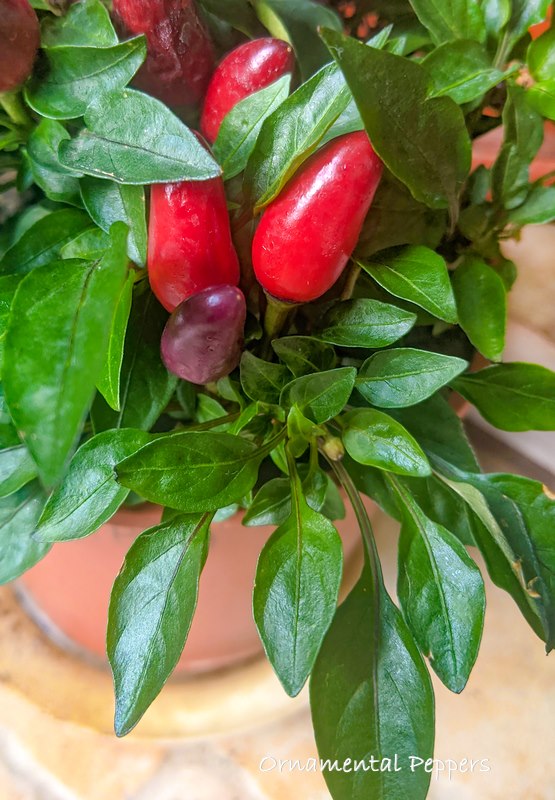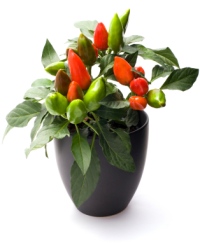Ornamental Pepper Plant Care
Botanical Name: Capsicum annuum
Grown for its brightly colored fruit, ornamental pepper plant is not particularly attractive until it becomes loaded with ripening peppers in fall and winter.
 Capsicum annuum 'Masquerade' has purple peppers. Photo © Gherghescu Angelica Florica
Capsicum annuum 'Masquerade' has purple peppers. Photo © Gherghescu Angelica FloricaGet to Know Ornamental Pepper as a Houseplant
White, star-shaped flowers grow in the leaf axils in summer and early fall, followed by the real star of the show -- colorful peppers.
Capsicum annuum puts on a spectacular display when covered with a bounty of colorful peppers. However, it's a one-time production. You can expect ornamental peppers to produce fruit for up to 6 weeks. It will not bear fruit again and is usually treated as a temporary houseplant and discarded after the peppers have dried up.
Ornamental pepper plants are native to South America, where they flourish in a warm, humid environment year-round. How big does it get? You can expect your indoor pepper plant to reach a height of 1 ft (30 cm).
Ornamental pepper is often sold as a gift plant, already in colorful fruit, before the holidays. Another common name for it is Christmas Pepper.
Ornamental Pepper Varieties
Peppers may be cone-shaped, round, or long and slender, depending on the variety. But the peppers all change colors as they mature -- from green to yellow to orange to red. Some varieties have purple fruit that is almost black.
These are often sold as holiday plants for their resemblance to tree lights. Choose whatever tickles your fancy... there are many good varieties to choose from.
- 'Black Pearl' is a popular cultivar with round, dark-purple peppers that turn almost black...and unusual dark foliage, making this a striking ornamental.
- 'Holiday Cheer' features small, round peppers that change from cream to yellow to red.
- 'Fireball' is a compact plant with round peppers that go from cream to orange to red as they mature.
- 'Masquerade' has cone-shaped peppers that turn purple.
- 'Chilly Chili' has long, slender peppers, turning yellow then red. This ornamental pepper plant is non-pungent, making it family-friendly and pet-safe.
Indoor Ornamental Pepper Plant Care

Light: Bright light, including at least 4 hours a day of direct sun. If you don't have a sunny spot indoors, scoot your pepper plant to your sun-drenched patio or porch for the summer. Or set your plant under a grow light for 14 hours a day to give it the light it needs to flower and grow peppers.
Water: Keep soil evenly moist. Leaves will drop if soil is too wet or too dry. Use a pot with drainage holes, water thoroughly, then empty drainage tray.
Humidity: Average to moderate humidity (around 50% relative humidity). Keep your ornamental pepper plant away from drafts and heat vents. Hot, dry air will cause the leaves to shrivel and turn brown. Dry conditions also attract spider mites. Mist the foliage with tepid water to raise the humidity around it.
Temperature: Cool at night, 55-60°F/13-16°C; warm during the day 70-75°F/21-24°C. Keep this tropical native warm. Ornamental pepper plants are tender and should not be exposed to temps near freezing.
Soil: Any good-quality, all-purpose potting mix
Fertilizer: Feed monthly. Tomato fertilizer works great for your peppers, too.
Propagation: Seed. Sow seeds in spring. Cover seeds with about 1/4" (6 mm) potting mix. Don't bury them; the seeds need light and warmth to germinate. Aim to keep the seeds around 70°F/21°C or warmer.Water lightly to keep seeds moist. You should see them sprouting in about 1-2 weeks.
Ornamental Pepper Plant Problems, Solutions and Answers
Leaves falling off? Both dry or soggy soil can cause leaf drop. Use a container with drainage holes, and water often to keep the soil lightly moist at all times.
No blooms? Your plant isn't getting enough light. See "Light" tips below.
Are ornamental pepper plants edible? They're not poisonous, but most are fiery hot and not suitable for eating. The juice from them can cause painful burning of the eyes and mouth. Wash your hands thoroughly after handling the peppers. Keep plants away from small children and pets. It's a good idea to wear gloves while pruning or repotting your plant.
Something bugging your plant? Pests are unlikely indoors, but watch for aphids, whiteflies and spider mites. If your plant spent any time outdoors, check it for insects. It's a good idea to rinse it off and allow it to dry before bringing it back indoors.


